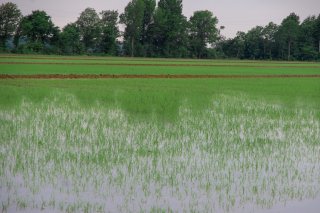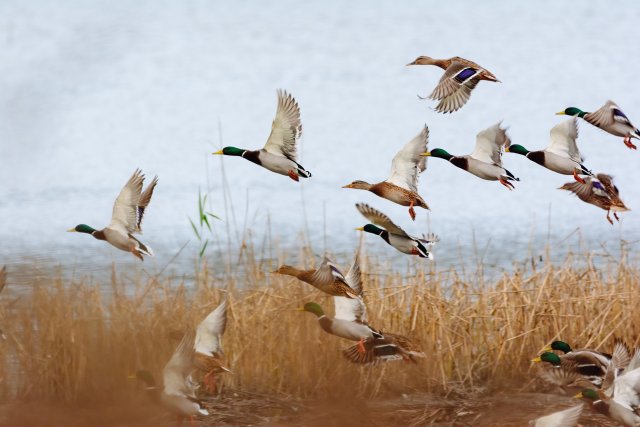Climate Change Connections: Arkansas (Duck Hunting)
Climate change is impacting all regions and sectors of the United States. The State and Regional Climate Change Connections resource highlights climate change connections to culturally, ecologically, or economically important features of each state and territory. The content on this page provides an illustrative example. As climate change will affect each state and territory in diverse ways, this resource only describes a small portion of these risks. For more comprehensive information about regional climate impacts, please visit the Fifth National Climate Assessment and Climate Change Impacts by Sector.
On this page:
Introduction: Ducks, Farmers, and Hunters: A Mutually Beneficial Relationship
Duck hunting is a popular pastime for many Arkansas residents and visitors. Arkansas borders the Mississippi River and sits in the southern part of the Mississippi Flyway. Ducks, geese, shorebirds, and other waterfowl use this route to migrate south during winter, stopping in wetland habitats along the way. The swamps of the Mississippi River Valley are important stopovers for migratory birds on their long journeys. The Arkansas Game and Fish Commission maintains wildlife management areas that include many of these swamps and reservoirs, with over 50,000 acres open to the public for hunting.2

Arkansas is also a prime spot for migratory birds due to its major crop: rice. As the largest producer of rice in the United States, accounting for nearly 50 percent of national production, Arkansas has over 1 million acres of rice fields.3 To help control weeds and improve rice growth, farmers flood thousands of acres of these fields in the winter, just as migratory birds are searching for food and habitat. Flooded rice fields provide an important source of food energy for ducks.4 They also provide duck hunting area for the thousands of people who flock to Arkansas annually to participate in the tradition.
Ducks, farmers, and hunters have a mutually beneficial relationship. Studies have shown that ducks provide soil turnover and weed control, improving rice growth.6 Efforts like the Arkansas Waterfowl Rice Incentive Conservation Enhancement Program and those through Ducks Unlimited organize financial benefits for farmers who leave their rice fields flooded or untilled, thereby leaving uncultivated rice as food for migrating waterfowl.5 Revenue from equipment sales and hunting licenses, such as the Federal Duck Stamp program, funds habitat restoration and supports wildlife management.7 The duck hunting industry contributes to Arkansas’ economy and helps protect the environment.
Climate Impacts: Warming Winters Can Influence Bird Migration
As the Earth warms, average temperatures increase throughout the year, but the increases may be larger in certain seasons than in others. Winter is particularly vulnerable to rising temperatures. Changing winter temperatures directly influence the amount of snow that falls and accumulates, amount of seasonal snowpack, timing of snowmelt runoff, loss of soil moisture, and amount of time that lakes are frozen. Seasonal warming could also disrupt the timing of events that are important for plants and animals, such as budding, hibernation, and migration.8

Typically, cold winters in Canada and the northern United States bring snowfall and freezing temperatures that lock up ponds and wetlands. As food becomes scarce, ducks and geese migrate south to find habitat and sustenance. These migrations usually begin in the fall and last throughout the winter months. As climate change warms the continent, winters are becoming milder. States like Wisconsin and Minnesota in the northern part of the Mississippi Flyway warmed more than 2°F over the past century, and projections show average temperatures for those states increasing another 2°F to 8°F or more by the middle of the 21st century.9 Because snow conditions and cold temperatures are a trigger for ducks to migrate, ducks may not fly as far south as winter conditions change.10 Popular game species like the mallard and the American black duck showed reduced southward migration between 1976 and 2013, flying shorter distances or staying in place.11 Changing migration could mean that ducks won’t arrive in Arkansas in time for the November start of the duck hunting season—if they arrive at all.
Higher temperatures and changing precipitation patterns can also dry out waterfowl habitat and threaten rice crops. While the rate of warming in Arkansas has not been as high as other regions of the country, the warmest five-year interval on record was 2015–2019, and temperatures are expected to continue warming through the 21st century.9 These rising temperatures increase drought risk and lead to reduced water availability for farmers, especially those who farm rice, a water-intensive crop.12,13 Drier conditions are not only more expensive for farmers, who must pump water in for irrigation, but they can also reduce the available habitat for ducks during the winter.
While drought presents challenges for ducks, flooding can also reduce natural food sources for ducks. The incidence of extreme rain events and flooding has increased in Arkansas.9,14 Flooding in natural wetlands can kill off species of oak trees that drop acorns that waterfowl consume.15 Anecdotally, such changes to the tree composition of wetland areas appear to align with changes to the presence of migratory waterfowl.14 Meanwhile, flooding also brings challenges for farmers, who must adjust to wet soil and erosion after extreme rain.
This combination of factors could be contributing to fewer ducks in Arkansas. Drought conditions have also reduced habitat for breeding ducks in Canada in recent years, leading to fewer ducks in the United States overall.16 The U.S. Fish and Wildlife Service reported a total duck population decline of 12 percent between 2019 and 2022, with a 23 percent drop for mallards.16 Although the interplay between duck populations and climate change is complex, it’s likely that changes in temperature and precipitation trends could further affect duck hunting.
Taking Action: Protecting Habitat in a Changing Climate
Addressing climate change requires reducing greenhouse gas emissions while preparing for and protecting against current and future climate impacts. Communities, public officials, and individuals in every part of the United States can continue to explore and implement climate adaptation and mitigation measures. In Arkansas, hunters, farmers, and conservationists are collaborating on habitat preservation initiatives to help Arkansas improve conditions for migratory birds, including by:
- Incentivizing creation and maintenance of habitats. The Arkansas Game and Fish Commission and the Migratory Bird Resurgence Initiative have made $4 million available to landowners who create duck habitat during the winter.17 Under this program, farmers can work with biologists to better understand habitat creation and receive up to $95 per acre to support their farms. The Arkansas Game and Fish Commission also receives habitat restoration grants to enhance and expand waterfowl habitat.18,19 The Arkansas Waterfowl Rice Incentive Conservation Enhancement Program offers ongoing financial benefits to landowners who ensure access to migrating waterfowl.5 Hunters can also actively participate in the commission’s meetings to provide input on hunting season dates and regulations.
To learn more about climate change impacts in Arkansas and the Southeast region, see Chapter 22 of the Fifth National Climate Assessment.
Related Resources
- EPA Climate Change Indicators: Heavy Precipitation
- Arkansas State Climate Summary 2022 (NOAA)
- Arkansas Game and Fish Commission: Waterfowl
- Climate Change in Arkansas (City of Fayetteville)
- A Warmer, Wetter World Impacts Arkansas Too (U.S. Fish and Wildlife Service)
- U.S. Department of Agriculture Climate Hubs
- Hunting, Fishing, and Climate Change (U.S. Fish and Wildlife Service)
- Arkansas Energy and Environment Innovation Plan (Arkansas Department of Energy and Environment) (pdf) (11.2 MB)
References
1 Herbert, J. A., Chakraborty, A., Naylor, L. W., & Krementz, D. G. (2021). Habitat associations of wintering dabbling ducks in the Arkansas Mississippi Alluvial Valley: implications for waterfowl management beyond the mallard. Wildlife Biology, 2021(1). https://doi.org/10.2981/wlb.00792
2 Arkansas Game and Fish Commission. (n.d.). Waterfowl. Hunting. Retrieved December 15, 2023, from https://www.agfc.com/hunting/waterfowl/
3 University of Arkansas Division of Agriculture. (2024). Rice production in Arkansas. Retrieved June 29, 2023, from https://www.uaex.uada.edu/farm-ranch/crops-commercial-horticulture/rice/
4 Havens, J. H., Kaminski, R. M., Davis, J. B., & Riffells, S. K. (2009). Winter abundance of waterfowl and waste rice in managed Arkansas rice fields. Journal of the Southeastern Association of Fish and Wildlife Agencies, 63, 41–46. https://seafwa.org/journal/2009/winter-abundance-waterfowl-and-waste-rice-managed-arkansas-rice-fields
5 Arkansas Game and Fish Commission. (n.d.). Arkansas Waterfowl Rice Program (WRICE). Education. Retrieved December 15, 2023, from https://www.agfc.com/education/arkansas-waterfowl-rice-program-wrice/
6 Wei, H., Bai, W., Zhang, J., Chen, R., Xiang, H., & Quan, G. (2019). Integrated rice-duck farming decreases soil seed bank and weed density in a paddy field. Agronomy, 9(5), 259. https://doi.org/10.3390/agronomy9050259
7 Crafton, R. E. (2019). Pittman-Robertson Wildlife Restoration Act: Understanding apportionments for states and territories. Congressional Research Service. https://crsreports.congress.gov/product/pdf/IF/IF12229
8 EPA. (2022). Climate change indicators: Seasonal temperature. Climate Change Indicators. Retrieved June 11, 2024, from https://www.epa.gov/climate-indicators/climate-change-indicators-seasonal-temperature
9 Runkle, J., Kunkel, K. E., Champion, S. M., Stewart, B. C., Easterling, D. R., & Nielsen-Gammon, J. (2022). Arkansas state climate summary 2022 (NOAA Technical Report NESDIS 150-AR). NOAA National Environmental Satellite, Data, and Information Service. https://statesummaries.ncics.org/chapter/ar/
10 Weller, F. G., Beatty, W. S., Webb, E. B., Kesler, D. C., Krementz, D. G., Asante, K., & Naylor, L. W. (2022). Environmental drivers of autumn migration departure decisions in midcontinental mallards. Movement Ecology, 10(1), 1. https://doi.org/10.1186/s40462-021-00299-x
11 Schummer, M. L., Coluccy, J. M., Mitchell, M., & Van Den Elsen, L. (2017). Long-term trends in weather severity indices for dabbling ducks in eastern North America. Wildlife Society Bulletin, 41(4), 615–623. https://doi.org/10.1002/wsb.837
12 Aide, M., & Guzman, C. T. D. (2020). Nexus of climate change and USA mid-south rice (Oryza sativa L.) production. Journal of Geoscience and Environment Protection, 08(12), 211–231. https://doi.org/10.4236/gep.2020.812013
13 Magugu, J. W., Feng, S., Huang, Q., Zhang, Y., & West, G. H. (2018). Analysis of future climate scenarios and their impact on agriculture in eastern Arkansas, United States. Journal of Water and Land Development, 37(1), 97–112. https://doi.org/10.2478/jwld-2018-0029
14 Chapman, D. (2023). A warmer, wetter world impacts Arkansas too. U.S. Fish and Wildlife Service. Retrieved June 29, 2023, from https://www.fws.gov/story/2023-04/warmer-wetter-world-impacts-arkansas-too
15 Gardiner, E. S. (2001). Ecology of bottomland oaks in the southeastern United States. U.S. Forest Service Southern Research Station. https://www.srs.fs.usda.gov/pubs/ja/ja_gardiner006.pdf
16 U.S. Fish and Wildlife Service. (2022). Waterfowl population status, 2022. U.S. Department of the Interior. https://www.fws.gov/waterfowlsurveys/docs/waterfowl-population-status-report-2022.pdf
17 Zellers, R. (2023). $4 million available for private landowners adding winter migratory bird habitat. Arkansas Game and Fish Commission. Retrieved June 29, 2023, from https://www.agfc.com/en/news/2023/06/21/4-million-available-for-private-landowners-adding-winter-migratory-bird-habitat/
18 U.S. Department of the Interior. (n.d.). Land and Water Conservation Fund. https://www.doi.gov/lwcf
19 Arkansas Game and Fish Commission. (n.d.). State Wildlife Grants. https://www.agfc.com/education/state-wildlife-grants/

